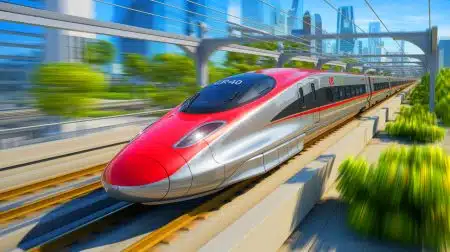| IN A NUTSHELL |
|
China’s latest breakthrough in magnetic levitation (maglev) technology marks a significant leap forward in high-speed rail innovation. Researchers have unveiled a novel solution to the “tunnel boom” phenomenon, a loud and jarring sound that occurs when high-speed trains exit tunnels. This advancement promises not only to enhance passenger comfort but also to address environmental concerns related to noise pollution. By integrating a 328-foot sound-absorbing buffer at tunnel exits, China is paving the way for a quieter and more efficient high-speed travel experience, potentially revolutionizing rail travel across the globe.
How the Buffer Works
When a high-speed train travels through a tunnel, it compresses the air in front of it, much like a piston. This compressed air then escapes at the tunnel’s exit, creating a loud thump known as “tunnel boom.” The issue becomes more pronounced as train speeds increase. At speeds approaching 373 mph, the boom can occur in tunnels as short as 1.2 miles. In contrast, conventional trains traveling at 217 mph require tunnels of at least 3.7 miles to generate a similar effect.
The innovative buffer designed by Chinese engineers is crafted from lightweight, porous materials. This buffer, along with a porous coating along the tunnel walls, allows the compressed air to escape gradually, akin to how a firearm silencer works. This design has demonstrated the ability to reduce pressure fluctuations by up to 96% in initial tests, significantly minimizing the tunnel boom effect. Such a solution addresses a critical challenge for future maglev trains, enabling them to operate at higher speeds without the drawbacks of increased noise and pressure.
How supercars are changing the face of automotive technology
China’s Revived Maglev Push
The introduction of the new buffer coincides with China’s renewed focus on maglev technology. The China Railway Rolling Stock Corporation (CRRC) is testing a prototype capable of sustained speeds of 373 mph. China’s current maglev service, the Shanghai airport shuttle, reaches 286 mph but covers only a short distance of 19 miles. However, with the new advancements, China aims to extend the range and speed of maglev lines.
This push comes as the country seeks to reduce reliance on domestic flights by offering a compelling alternative in the form of high-speed rail. The proposed maglev line between Beijing and Shanghai could match the flight time of 2.5 hours while offering a quieter, more cost-effective, and environmentally friendly option. While no official routes have been approved yet, several provincial governments are advocating for pilot lines, signaling a strong interest in expanding maglev infrastructure.
A Mixed Global Picture
China is not alone in its pursuit of advanced maglev systems. Japan’s Chuo Shinkansen aims to connect Tokyo and Osaka at speeds of 314 mph, potentially reducing travel time to about 67 minutes. However, the project faces delays, casting uncertainty over its anticipated 2027 launch. Meanwhile, South Korea has successfully implemented shorter maglev lines, showcasing their potential.
In contrast, the United States has hit obstacles. The federal government recently canceled funding for an East Coast maglev project due to planning issues, community opposition, and cost overruns. This divergence highlights the varying levels of commitment and success in adopting maglev technology worldwide. As countries explore high-speed rail, China’s new buffer technology offers a promising solution to one of the industry’s most persistent challenges.
Why trucks remain essential for small businesses in the modern era
The Road Ahead for High-Speed Rail
China’s pressure-relief buffer represents a significant step toward making super-fast rail travel commercially viable. If the large-scale trials confirm the 96% reduction in shock waves, this innovation could overcome one of the final technical hurdles hindering the widespread adoption of maglev technology. The potential for faster, cleaner, and more efficient travel could transform cross-country transportation, offering an alternative to both traditional rail and short-haul flights.
This breakthrough could lead to broader implications for the global transportation landscape. As the demand for sustainable and efficient travel solutions grows, the success of China’s maglev advancements might inspire other countries to accelerate their high-speed rail projects. The question remains: will this innovation trigger a new era of high-speed travel worldwide, and how will different nations respond to the challenges and opportunities it presents?
Did you like it? 4.6/5 (27)







Wow, 373 mph! That’s faster than most planes. What’s next, teleportation? 🚀
Wow, 373 mph! That’s faster than my WiFi 😅.
Can maglev trains really replace flights for long distances? 🤔
Is there any information on the cost of building these maglev lines compared to traditional railways?
This is amazing news! Thank you for the detailed article. 🚄
Sounds great, but will ticket prices be affordable for the average person? 🤔
Are there any safety concerns with the new maglev technology?
Thank you for this insightful article! It’s fascinating to see how far maglev technology has come.
Does this mean no more jet lag? Count me in! ✈️➡️🚄
Are there any environmental concerns with constructing these maglev tracks?
Will this technology be affordable for the average traveler?
373 mph sounds amazing, but what happens if there’s a technical issue? How do they stop in time?
How soon can we expect these maglev trains to be operational?
China’s really ahead of the game. Can other countries catch up?
I’m skeptical. Trains replacing flights? We’ll see about that.